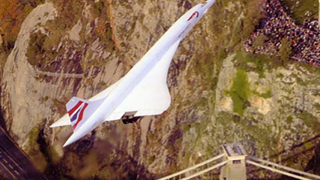
The last Concorde built is enjoying its retirement at an airfield just outside Bristol – a short drive from Dyson HQ.
An International Team
Concorde was the world’s first supersonic commercial passenger aircraft and a rare example of successful international collaboration. Born out of Anglo-French desire to respond to the Soviet-American space race, BAC and Sud-Aviation's Concorde first flew in 1969. Concorde represents a successful compromise between French and English engineering – reflected in the name, which means harmony, union and agreement.
Phenomenal speeds
At its fastest, Concorde flew from New York City to London in under three hours, and it routinely flew at more than twice the speed of sound. Its success lay in its beauty as well as its speed. Concorde’s delta wings and needle-shaped nose solved problems of visibility whilst enhancing performance. Cruising at Mach 2 also optimised fuel consumption.
Convention meets invention
Concorde was predominantly made of aluminium, to allow for conventional manufacturing while reducing weight. Its cruising altitude of 56,000 feet was higher than all other civic traffic, though, offering Concorde a dedicated oceanic airway over the Atlantic.
